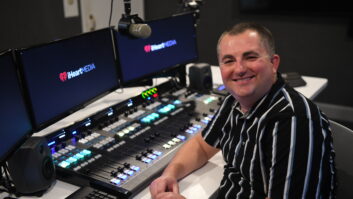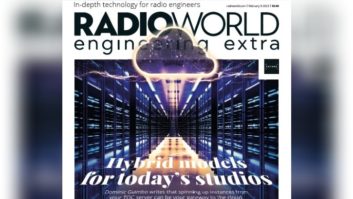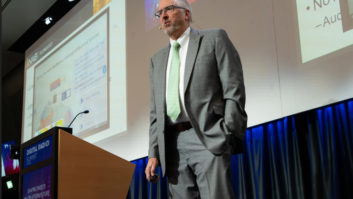The task of going digital
Aug 1, 2006 12:00 PM, By Jeff Smith, CEA CBNT
It was shaping up to be a typical NAB trip this past April when Tony Gervasi, senior VP of engineering and technology for Nassau Broadcasting, received a call asking if it would be possible to install HD Radio with a multicast signal on WFKB, Boyertown, PA. He was also asked if it could be done in 45 days. Never being one to step back from a challenge and knowing the capabilities of the Nassau engineering department, he said yes.
Immediately Gervasi and I sat down with vendors to form a plan. We selected a major broadcast supplier and integrator to supply most of the equipment and decided that split-level combing would be used. This would allow Nassau to continue to use its main Continental 316R transmitter and add a new solid-state hybrid transmitter capable of transmitting an analog only, digital only or hybrid signal. Nassau also decided to use the Dielectric Dibrid IBOC combiner. This combiner allows for hot switching between the transmitters, which allowed Nassau to use the new hybrid transmitter as a backup analog transmitter if necessary.

The new equipment is delivered.
The order was finalized and a delivery date of June 12 was set for the equipment to be delivered to the transmitter site. It was critical for the equipment to arrive by this date, because a firm on-air date of June 22 was set for the new HD Radio configuration. Unfortunately, the supplier missed the delivery date and only a partial order arrived nearly 36 hours late. The remainder of the equipment did not arrive until June 17 � five days after the promised delivery date. This created a serious issue for the Nassau six-man staff but the engineering team persevered in its effort to complete the project on time.
Time to begin
With all the equipment finally on site, the team began installing nearly 80 feet of Myat 3 1/8″ rigid line and 20 elbows. Included in the install of the new transmission line were three Bird BPME series power monitors and an Electro Impluse 10kW reject load. The Bird meters provide an IP connection to remotely monitor power at certain points in the air chain.
While this was going on at the transmitter site, engineers were also busy installing the HD Importer and Exporter and audio processing equipment at the studio site. An Omnia EXI HD+FM was chosen for the main processing. This provided the delay necessary for the digital signal to be handled in the processor. By delaying the audio here it allows the analog portion of the signal to not pass through the exporter, which in turn helps to keep the analog FM signal on the air in the event the Exporter needs to be rebooted. Gervasi chose an Orban Optimod 6200 to process the HD2 signal, which is a simulcast of the WBYN-AM Christian format. Also installed at the transmitter and studio sites were Audio Design Associates HD Pro Tuners. These tuners monitor the analog, HD1 and HD2 signals in one unit with balanced XLR and AES/EBU outputs.

The hybrid transmitter is set into place.
The Moseley Starlink SL9003Q with the LAN option was used as the STL. This allowed for the analog signal as well as the UDP traffic for the digital signal to be sent using one device. Once the audio arrives at the transmitter it is fed into an exciter that powers the Continental and the new hybrid HD Radio transmitter. With split-level combining we were able to reduce the TPO of the Continental from 20kW to 16.5kW. The new hybrid transmitter made up the difference by producing 3.5kW of analog power and 800W of digital power. The two transmitters, when combined using the Dielectric Dibrid, create the power needed for WFKB.
Nassau chose the Dibrid combiner because it features multiple modes and allows for hot switching. Mode one combines the two transmitters’ analog and digital signals with 4.5dB loss. Mode two routes the Continental to the antenna. Mode three routes the hybrid transmitter to the antenna and mode four combines the full power of both transmitters with a 10dB loss. The Dibrid rejects any excess power to the 10kW Electro Impulse convection-cooled reject load.

The Agilent spectrum analyzer shows that the hybrid HD Radio signal easily fits the spectrum mask.
Nassau’s engineering team successfully turned on the digital signal on June 22, even with the shipment delays. The new digital signal was monitored and tested using an Agilent E4402B spectrum analyzer and shown to fit perfectly within the Ibiquity HD Radio mask.
With the WFKB signal now on the air in HD Radio and sister station WBYN-AM on the HD2 signal, it is Nassau’s goal to spread the word about HD Radio in the Reading, PA, area. To that end Nassau has purchased 200 Boston Acoustic Recepter Radios from BGS to distribute to listeners. Nassau hopes that by being the first HD Radio signal on the air in Reading that the WFKB classic hits audience and the WBYN Christian audience will be better served and enjoy the listening experience.
Smith is director of broadcast systems, Nassau Broadcasting Partners.












